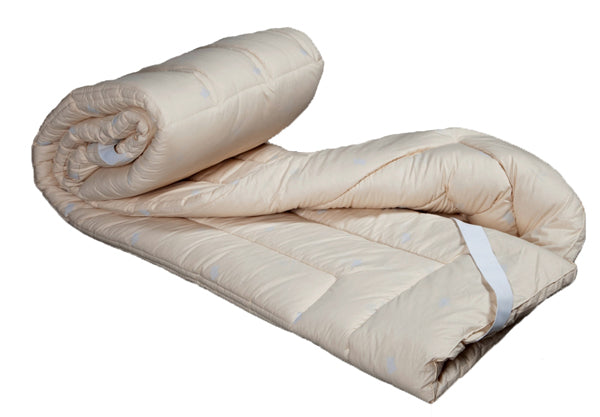Organic Bedding and Wool: 2 Things You Need to Know

If you are considering organic and natural bedding of any sort, be it a mattress pad or topper, comforter or pillow or even a natural latex mattress you’ll need to know a bit about wool. Pure, natural wool is one of the primary materials used in natural and organic bedding and mattresses.
As you begin to investigate you’ll see that the wool is labeled differently in different products. You might see it labeled as organic or certified organic, PureGrow™ Wool or Eco Wool. Why all the different labels? After all doesn’t “pure and natural” mean chemical-free? Not always.
Although wool is a natural material not all wool is produced without chemicals. That’s why when shopping for natural and organic mattresses and bedding, it’s important to ask how the sheep are raised and how the wool is processed. Start by asking:
Are the sheep raised without chemicals and treated humanely?
Wool labeled “certified organic” means the sheep are raised by U.S. or non-U.S growers in accordance with USDA standards for organic livestock. These standards prohibit the use of synthetic pesticides in the pasture and on the wool. Sheep cannot be dipped in harsh insecticides to control parasites. Managing good animal health through certified organic feed and forage is also encouraged under these standards, along with grazing methods that do not exceed the natural carrying capacity allowed on the land.
By comparison, wool labeled PureGrow™ Wool and Eco Wool is not certified organic. However, under these programs sheep are raised by small-scale U.S. regional farmers who follow sustainable and cruelty-free guidelines, created by their respective participants, which often meet or can exceed organic standards. These labels ensure the wool comes from happy, healthy sheep -- grown without chemicals and pesticides and not overgrazed or inoculated withsynthetic hormones.
When we buy natural and organic bedding products for our store, for instance, we look for wool fiber that comes from woolgrowers who are certified organic, or from growers who don’t hold the certification but are committed to sustainable farming practices and can demonstrate they raise their sheep and care for their land without the use of harsh chemicals.
The next step in determining the purity of the wool is to ask:
Is the wool cleaned and processed without chemicals?
The answer to this question is perhaps the most important one to understand when making a purchasing decision.
A finished wool product isn’t always chemical-free simply because the sheep were raised “organically”, the fleece must also be cleaned and processed without harsh detergents, bleaches, dyes, crimping chemicals or acid baths.
For example, the layer of wool in our Savvy Rest’s mattress casings is certified organic. The wool comes from sheep raised to meet the USDA standards for organic livestock. The fleece is then sent to a carding mill that processes it in compliance with the Global Organic Textile Standards (GOTS) – this ensures the fleece is turned into batting without the use of harmful chemicals at any stage of the processing.
Keep in mind that many natural bedding products use wool that is not certified organic but still is made from wool that is grown and processed without synthetic chemicals, such as PureGrow™ Wool and Eco Wool.
What about wool bedding that is referred to only as “pure and natural” or “organic”? Buyer beware. Wool used in products with vague labeling might be grown and/or processed with pesticides, harsh chemicals and dyes. Shop from retailers and manufacturers that support sustainable wool production and who are transparent about how the wool in their products is grown and processed.
Whether you’re considering a natural latex mattress with wool in the casing, or a wool pillow or wool comforter, make sure the wool is free of chemical irritants. By reducing our exposure to chemicals in our mattresses and bedding we sleep healthier, more comfortably.
